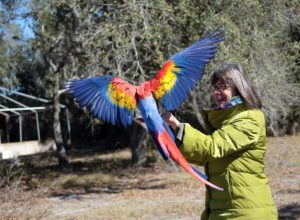While seminars and webinars are a fabulous way to learn from the dog training industry’s well-known experts, it is not often we’re able to pull them aside and ask off-the-cuff questions. With this series, I’m asking some questions that are a bit different to get to know these dog training legends on a deeper level.
 First up is Susan G. Friedman, Ph. D. She runs an exceptional online course called “Living and Learning with Animals for Professionals.” I participated in this course back in 2011 and it was truly eye opening. I consider it a must-take for all up and coming dog trainers and list it in my article, “6 Places to Get a (Fairly) Formal Education In Dog Training.”
First up is Susan G. Friedman, Ph. D. She runs an exceptional online course called “Living and Learning with Animals for Professionals.” I participated in this course back in 2011 and it was truly eye opening. I consider it a must-take for all up and coming dog trainers and list it in my article, “6 Places to Get a (Fairly) Formal Education In Dog Training.”
Susan G. Friedman, Ph.D. is a professor emeritus in the Department of Psychology at Utah State University. She has helped pioneer the cross-species application of behavior analysis to animals, using the same humane philosophy and scientifically sound teaching technology that has been so effective with human learners. Susan has co-authored chapters on behavior change in four veterinary texts, and her popular articles have been translated into 14 languages. She gives seminars on animal learning at conferences and consults with zoos around the world. Susan is a member of Karen Pryor’s Clicker Expo faculty and teaches yearly hands-on animal training workshops with Steve Martin (www.naturalencouters.com). Susan was appointed to the F&WS Condor Recovery Team from 2002 – 2010, after which time the team was retired due to the success of the birds in the wild. She is the Chairperson of the Scientific Advisory Committee of American Humane Association (AHA) Film and TV Unit, and a member in good standing of ABAI, ABMA, IAABC and IAATE. Last year she was included on the Vet Tech College’s list of “15 Animal Professors to Know.” Susan’s acclaimed online course, Living and Learning with Animals for behavior professionals, has provided even wider dissemination of effective, humane behavior change practices to students in over 35 countries (www.behaviorworks.org). And she shares fun videos with a science twist at facebook.com/behaviorworks.
Here’s what she had to say about how she got started and where she’d like to see the dog training industry go.
Thank you again for taking the time to share your thoughts and experiences with me and the readers of The Modern Dog Trainer!
My first question is, how did you first get involved in the dog (animal?) training world?
My professional work with animal learning started with one little parrot, twenty years ago! I read all the popular literature on companion parrots at the time and could hardly believe the extent to which punishment strategies were recommended. The experts of the day were stuck in the cultural fog. Thankfully that is changing now and there are many voices singing a different, more effective tune based on positive reinforcement of desired behavior, which benefits all learners.
What made you decide to teach the Living & Learning with Animals course online?
I realized that education about the science of behavior change, called behavior analysis, was key to changing people’s understanding of how behavior works. Punishment works, but there are side effects that are not only detrimental but also unnecessary. Positive reinforcement generally produces not only fast learning but enthusiasm for learning as well. It may surprise your readers that I assert that positive reinforcement produces fast learning outcomes. I think that positive reinforcement only appears to be slower because as a generation, we are relatively new to teaching with positive reinforcement. The next generation, who will grow up with positive reinforcement as a life style, will blow our minds with their skilled, effective, and humane practices.
Who benefits the most from taking your online course?
Anyone interested in behavior and learning will find the information life changing – so my past students say! Behavior, like any other natural phenomena on the planet is lawful. Of course, we don’t know all the laws and variations … what science is ever complete? But, we certainly know enough to improve quality of life for all learners in our care. This information is empowering and applicable to all aspects of our lives. My co-instructors and I are very happy messengers and students of our students too, sometimes!
In your experience, what do dog trainers struggle with the most when it comes to Applied Behavior Analysis?
I think we all struggle a bit with our own learning histories. For example, even the most experienced positive reinforcement trainers sometimes revert to a command tone of voice or eye rolling when an animal behaves unexpectedly. We have to be open to reminding each other that the learner is never wrong. When an animal doesn’t do what we expect, it’s the program. And, the solution is to change what we, the trainers, do. To change behavior, change conditions. The animal changes himself/herself.

What are the keys to success in Applied Behavior Analysis?
Great teachers of any species meet their learners where they are, not where we wish them to be. The main key is the knowledge that all behavior is influenced, at least some degree, by conditions. The environment influences all systems including gene expression and brain function. Since we control most of the conditions in which our learners behave (or “misbehave”), there are always way to successfully change behavior.
Can you describe a particularly difficult client who used ABA process successfully?
Honestly, I don’t think of clients in terms of difficulty. But, the most difficult ABA plans to implement are those that require unavailable resources like more space, more enrichment, and more time. I guess what I’m describing is a recent insight for me that learners always bring natural flexibility and resilience to the table; but if we can’t significantly change the conditions that support the problem behavior, success remains out of reach. I’m quick to remind clients that if they can’t change either the antecedent environment and/or the consequences that follow the behavior problem, there can’t be a learning solution. That usually results in some increased openness to change.
How can dog trainers better prepare themselves before they begin taking on clients? (With relation to their education, with their handouts or written materials for their clients, or anything else they should consider before getting started.)
Trainers will be better prepared by reading a basic science of behavior and learning textbook or two (e.g., Chance), and (this may seem out in left field) a special education, applied behavior analysis text book (e.g., Miltenberger). The former will provide the fundamental science information required for understanding the big picture of behavior and learning on planet earth, and the latter will provide the best application information. Connecting the dots across species is the easy part.
Do you have any role models or people you look up to in the animal training industry? (Who and why?)
Finding role models is my special talent! I have been privileged to learn from so many teachers, trainers, and scientists that I truly believe I’m the luckiest teacher on earth! I actually drove B.F. Skinner home from the residential treatment center where I worked (he was on the Board of Directors) when I was 20 years old! Now there’s a brush with fame I’ll never forget. Talk about influence!
How do you hope the dog training industry will evolve in the future? What do you want it to look like?
I hope that the dog training profession will continue to include more from the science of behavior and learning. I know that working across professions, as we routinely do nowadays, we will continue to raise the ceiling and provide even more humane, effective help to greater numbers, sooner.
Where will people be able to see you speak in the coming year? Where can people learn more about your online course?
I invite your readers to download anything helpful from my website, www.behaviorworks.org. There are dozens of articles (including translations in 14 different languages) and fun graphics for T-shirts or print material. My speaking engagements are listed on the website too. With my wild travel schedule, I’m bound to cross paths with your readers. I hope they will introduce themselves and share a hug. Together we are changing the world!
Looking into becoming a dog trainer?

Grab our free eBook, “10 Common Mistakes New Dog Trainers Make With Their Businesses.”
If you’re thinking about starting your own dog training business, take advantage of this free eBook to avoid some detrimental mistakes that many dog trainers make.
Are you spending your time on the right tasks to grow your business? Are you worried about making continuous income throughout the year? Will your business be sustainable for years to come? Prepare yourself with the help of this eBook!



